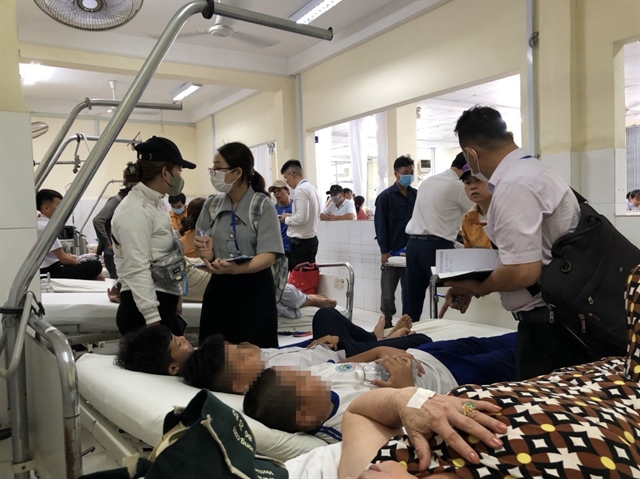 Society
Society

 |
| Director of HCM City Food Safety Department Phạm Khánh Phong Lan. — Photo dantri.com.vn |
Multiple food poisoning cases among students in Khánh Hòa and Lâm Đồng provinces in recent months have raised the alarm about quality of food sold to children in stalls near schools. Director of HCM City Food Safety Department Phạm Khánh Phong Lan spoke to Dân Trí online newspaper on the issues and measures to prevent similar incidents.
How do you assess the current situation of food safety around schools nationwide?
Food sold outside of school is divided into two categories. In the first, dishes are sold in food service establishments regulated by food safety regulations. The second category, street food, is more harmful to children. The younger they are, the more dangerous it is.
Children don’t have much awareness of food safety yet and they are easily attracted by colourful items. With the mobile stalls in front of the school and the fear of authorities, vendors are ready to run off anytime they need to. This street food is often not covered against bugs and dust, heightening its risks. Children also play and share food with each other, so there are even greater chances of mass poisoning.
We have seen an increase in food poisoning cases reported since the beginning of the year. There are many reasons for this situation, the first being inadequate communication regarding food safety for the right actions from the community.
The second reason is that after the difficult economic circumstances of the pandemic, people are more relaxed in their diet and tend to spend less on food. That means vendors are compelled to use less safe raw materials to reduce costs, and they may also skip steps in food safety procedures.
No official conclusions have been issued yet on recent food poisoning cases, especially the one in Nha Trang City. However, there are many risk factors that we cannot thoroughly eliminate.
For example, food can be contaminated at source, in the importing stage or microbiological testing, or if there is cross-contamination when raw and cooked food come in contact with one another during processing. Then the next questions are how are the ingredients cleaned, are they using tap water or water wells to cut costs, is the water from the well contaminated, and how long do they store the food?
In food establishments with food safety certification, the majority of the dishes are cooked. As for street stalls, even if the dishes are cooked at high heat, how do they clean the utensils? There is now disposable packaging, but the risks of unsanitary remain.
Desserts soaked in sugared water or pickled fruits also pose contamination risks. As for sushi, in the cases we inspected, several stalls use rice water from the day before to make the dish which is left overnight and sold to schoolchildren the next day. This is very alarming.
Regarding students’ physical conditions, we cannot rule out psychological factors - when they see others having stomach aches, they may be worried and have the same issue. Sometimes this happens en masse. Authorities must consider the case from every aspect.
In January, multiple students in Nguyễn Hiền Primary School in Thủ Đức City showed symptoms of stomach ache and nausea. Authorities did not conclude this a food poisoning case but this incident still raised alarm on food safety on school campuses in HCM City. What actions has the city’s food safety department taken to address this issue?
We have been cautious right from the beginning. In the past year, we deployed multiple inspection teams to survey kitchens, canteens and food providers for schools on their compliance with food safety regulations.
We also invite parents on campus to co-monitor the stocking procedures. The raw ingredients must have clear origins and meet standards such as VietGAP, GlobalGAP or other safe food supply chain requirements.
HCM City on Wednesday (April 17) also launched Action Month for Food Safety. The Food Safety Department will conduct unscheduled inspections and strictly handle cases of food safety non-compliance despite repeated warnings.
We are determined to be objective. The principal must be ultimately responsible for safe meals for students. We do not allow food poisoning to happen in schools at any cost.
It is also necessary to strengthen the management of street food near campuses. Current regulations do not require street vendors to register their businesses or apply for food safety certification.
People’s Committees at district and ward levels hold direct responsibility for raising awareness and monitoring mobile food stalls around campuses and in front of school gates. At the same time, the food safety department is also responsible for providing training for food providers.
People and communities play a crucial role. Every parent should teach their child against eating food from unknown sources while managing their spending. When I was young, if I wanted something, my parents would ask teachers to buy it for me through the school canteen, where all knew the origins of the products.
 |
| Many children with symptoms of food poisoning were treated at Khánh Hòa Provincial General Hospital on April 5 after eating food sold in front of their school. — VNA/VNS Photo |
What are the results of HCM City Food Safety Department’s inspection visits in schools?
Our regular and irregular visits showed that HCM City’s schools have generally good responses to standards, which means food safety for students is ensured. These results do not appear out of the blue but are the success of the coordination between the city’s Department of Education and Training and the Food Safety Department.
Incidents still occur, such as the case at Nguyễn Hiền Primary School or several other institutions, but in a small number. Tests of samples taken from the cases were not able to identify the cause of the students’ health issues, therefore there was not enough data to conclude that this was a case of food poisoning.
However, we could not sit still or let down our guard. It is a must to ensure food safety in the new context where wars in other parts of the world, challenges in economic recovery and reduced income will increase the chance of unsafe food. It takes little time to commit a violation of food safety but it is not at all simple to have proof of that act.
In the future, we will continue to coordinate, inspect and remind schools to be aware of the origins of the food by checking invoices and certificates. They also need to ensure the four-step food processing for cleanliness and that no bug comes in contact with the food. Schools must have a kitchen for cooking. If they procure meals from outside, the food providers must meet all food safety requirements. They absolutely cannot leave meals for hours or overnight without proper storage. Finally, each school must prepare response plans in case of food poisoning and how they will take test samples to determine the responsible and prevent unsafe food from being brought elsewhere.
Street food businesses without licences means they have not undergone initial evaluation. How can authorities manage food safety for products sold by street vendors outside of schools?
From a management perspective, we have on-site human resources which are of wards and districts as well as local police and security forces. HCM City has around 15,400 street food stalls across 21 districts and Thủ Đức City, and there are specific data in each area. Vendors do not spontaneously put up a food stand on the street, they have their regular spots and customers. They also try to comply with food safety regulations because if their food does not sell, that will affect their family’s livelihood.
We recommend local authorities advocate and provide training on food safety for street vendors, so that they have awareness in every step of preparation, such as storing food in glass or covered cabinets to protect it from dust, or using food gloves or tongs to pick up the food instead of using bare hands.
At the same time, district authorities must have criteria to develop safe street food selling locations, and of course, the number one priority is food sold around and on campus.
Regarding street food vendors, they indeed can operate without initial evaluation for a food safety certificate. However, this assessment is only temporary. It is important to have post-inspection checks to ensure the quality. If violations occur, we will take samples for testing and review their documents to trace the unsafe food sources and issue penalty decisions.
What can people do to identify and prevent unsafe food?
There are still risks of unsafe food, and for children, these risks do not exist in school but also at home. Therefore comprehensively speaking, it is a must to ensure the sources of the food brought into the city through wholesale markets and supermarkets, which is evident in annual reviews. We are improving to raise the standards of food safety.
We have an advantage which is also a challenge: any suspected case of food poisoning is promptly reported in the press, which increases public awareness. This may make them feel anxious, thinking everything is unsafe and afraid that anything they eat can cause illness.
We have been promoting community supervision by requesting parents to actively engage in monitoring their children’s meals. HCM City Food Safety Department also set up a hotline at 02839301714. At any time, people can reach out to us and we will respond. We must prevent risks of poisoning before our children consume the food, and that requires authorities. — VNS




